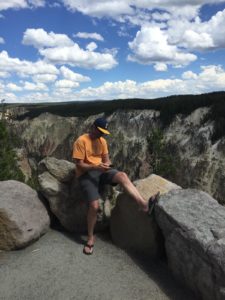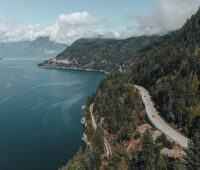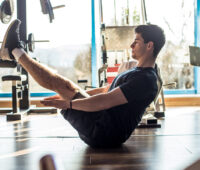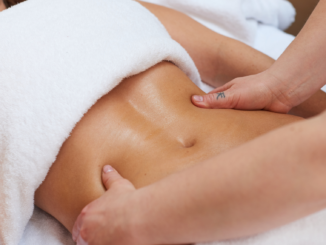
Aggressive high-speed mountain biking by expert riders can be considered an extreme sport right up there with aerial freestyle skiing. But some people call it “the new golf” and beginners of any age needn’t be intimidated. With the right equipment and positive mental and physical orientation, most people can learn to enjoy mountain biking in their first few outings. They can then progress to higher levels of skill at their own pace, according to experienced enthusiast Michael Hagele.
One option is to attend a mountain bike skills camp. Excellent programs may be found in California, the mountain West, northern Virginia and the Northeast U.S. Otherwise, it makes a lot of sense to start off mountain biking locally with a like-minded and similarly situated buddy or two, preferably someone who’s already been initiated. Anyone who can provide live trail forecasts on site as you get moving on your first off road ride will allow you to anticipate what’s coming up next.
Introducing the Rigors of Off-Road Riding
Many major metro areas including Chicago and Atlanta now have mountain biking parks with groomed training tracks, graded by degree of difficulty. These tracks are perfect for beginners just getting the hang of changing gears on their bike and steering around various obstacles. They also offer the opportunity to learn from watching other more experienced riders and interacting with them on site.
Depending on the topography of the region where you live or go on vacation, off road biking trails can take you along well-worn smooth paths, easy terrain and rolling hills. Or the trails can lead over truly mountainous terrain with steep inclines, rockslides, running streams and nearby cliffs. And of course, there’s everything in between to be discovered as well.
Just finished a Ride on Strava for 1 hour, 3 minutes, 36 seconds going 33989.7m. https://t.co/NgOeNi27Zc
— Michael Hagele (@Michael_Hagele_) June 13, 2018
You might ride mostly under a wide-open sky exposed to intense sunshine and maybe a field of wildflowers, or through thick forests fully shaded by a canopy of leaves and branches. Even marked riding trails may contain tree roots and fallen branches, slippery leaves, moss and pine needles. Rocks ranging in size from big boulders to gravel patches can be encountered along the way, so you need to be ready for anything, especially on an unfamiliar trail.
You might also encounter slippery shallow mud or deep puddles anywhere your biking adventure takes you, especially if heavy rains have fallen recently. However, strategically chosen rest stops along biking trails often deliver amazing panoramic vistas of mountains and valleys, lakes and streams or just the quiet sights and sounds of nature 360 degrees around you.
Paved road cycling on lighter weight bikes can sometimes morph into a hybrid mountain + biking experience such as at the annual Whiteface Mountain race held in the late spring in Wilmington, NY. The racecourse spans 11 miles mostly uphill on a winding mountain highway, finishing at the summit at over 4865 feet above sea level, in the Adirondacks. As challenging as it is though, that’s not really mountain biking. It’s uphill road racing.
Michael Hagele Says Start with a Great Piece of Equipment
Michael Hagele, a tech industry professional who rides as part of his daily routine, recommends that beginners find high quality equipment to use whether it is rented, borrowed or bought. All mountain bikes have a sturdier, thicker frame and wider tires kept at lower air pressure than road bikes. They boast twice the number of gears as a road bike, such as a 21, 24 or 27 speed gearing system.
Other performance features suggested for mountain bike riders just starting out include:
- Dual suspension system – front and rear — not just a front end — for optimal
shock absorption and no ‘hard tail’
- Disc braking – a closed system of hoses and reservoirs containing hydraulic
fluid for extra stopping power, speed modulation and all-
weather performance
- Hydraulic seat post dropper – adjusts pedaling seat height on the fly to make
navigating technical sections of a trail easier
and more fun
Mountain biking is a bumpy ride that compares to off-roading in a jeep vs. riding in a luxury car on a highway, so you want the maximum cushion that dual suspension systems provide. Hydraulic disc brakes are important for control and safety because they are closed off from weather elements, dirt and debris. They are stronger and more durable than V-brakes and deliver all-terrain effectiveness.
A hydraulic seat post dropper is a telescoping post that is activated remotely via a lever carefully placed on the bike handle. It allows you to lower your seat or “saddle” while in motion to drop your center of gravity and improve stability during steep descents. Having the seat out of the way also helps when leaning into turns, both sweeping and tight. The seat can be raised back to its original height at any time.
Hagele suggests that novice riders ask to demo a reasonably higher end mountain bike at their local bike store that rents bikes. They’ll often sell their rental bikes at a steep discount to get you into a quality bike. Take the time to let the staff help you choose a rental bike of the size and design that’s just right for you. If it doesn’t feel quite right on the first ride, explain why and grab a different one the next time.
Personal Equipment and Attire
A well-fitting helmet is probably the most important item you will wear. You should also choose a pair of sturdy flat ‘clipless’ athletic shoes. There’s no need to invest in super ‘grippy’ mountain biking shoes as a beginner. You do want to wear comfortable lightweight clothing that stretches and breathes. Spandex shorts without underwear and a cycling jersey are not essential, but perhaps remain the best choices.

Remember to bring hydrating fluids in a large water bottle that fits in the bracket on the center of the bike frame. And always carry personal ID with you.
Optional items for beginning riders include gloves for surer grips on the handles and a light backpack or fanny pack that fits securely and does not move around. For long backcountry adventures, you’ll want to take along a kit that includes: a trail map, energy bar, spare tire tubes, patches, tire pump, small tools and chain lubricant.
For shorter blast trail rides, if you feel you should bring your smartphone for safety reasons, turn it off at least while you’re riding to enjoy a truly untethered and unplugged experience. Otherwise, leave your device in your car or truck.
Physical Preparation to Ride
Mountain biking is an aerobic sport that delivers a cardio workout at any level of skill. So it’s best to get yourself in pretty good shape at the gym or cross-training in another sport before you take up mountain biking in earnest. Be sure to fuel up enough with a sufficient intake of nutritious calories earlier in the day. Then don’t forget to stretch and warm up your muscles.
Take it easy and progress gradually. Basic skills include: riding on the flats, descending, climbing, cornering and rolling over small obstacles. Avoid the temptation to race with your friends, or keep up with a highly skilled expert rider.
Be certain in advance that you can handle a particular feature on the track or trail before hitting it at even moderate speed. Jumping off something big and changing your mind at the point of launch is the surest way to wind up in the emergency room (or cemetery). Trees are especially unforgiving.
It’s also important to maintain a safe distance from other riders on the trail. Beginners should expect to pull over and allow others to ‘ride through’ on popular trails, especially on weekends and at other peak times.
Prep for That Day’s Environmental Elements
Sun, rain, storm forecasts, heat index, humidity, remaining daylight and air quality/pollution are all variable factors to be considered before you head out on a mountain bike adventure. They will determine whether you hit the trails at all on a given day, what you should wear (including sunblock/lip balm or insect repellent), what trail or track you choose and what distance or number of laps you plan to cycle.
As mentioned earlier, the weather on preceding days actually can be a factor if torrential rain fell in your area.
Mountain biking even at the beginner level provides healthy aerobic exercise for cardiovascular fitness and strength training at a minimum. Additional bonus benefits and advantages may await you around the next bend as well. Many people like Michael Hagele, who enjoy the sport regularly, find fresh perspectives on life and work out on the trail. They tend to draw creative inspiration from the physicality of the ride and the raw elements of the great outdoors.
Mountain biking is a global sport that has grown increasingly popular in such diverse places as Canada, Ecuador, Costa Rica, the Swiss and French Alps and Australia. Some hotels even provide equipment and facilities to their guests.
Even if you never personally opt for the extreme sport of competitive off-road racing, mountain biking is an exhilarating, immersive and vigorous activity that is never just another workout. It’s a dynamic and multi-dimensional experience for body and mind.
Find out more about Michael Hagele’s mountain biking excursions on Strava: https://www.strava.com/athletes/michaelhagele
Or his official website here: michaelhagele.com/














Leave a Reply
Be the First to Comment!
You must be logged in to post a comment.
You must be logged in to post a comment.